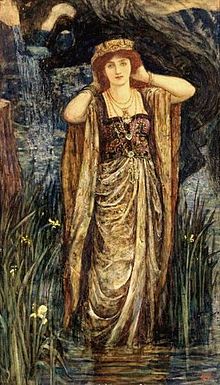
Guinevere, by Henry Justice Ford (c.1910).
Guinevere was the wife of the legendary British King Arthur in European mythology. She is known for two stories: her affair with Lancelot and her abduction, although in many versions these tales have become convoluted with one another. It was said that the treachery by his wife with his friend was the action that led to the defeat of King Arthur by Mordred at the Battle of Camlann. Her name is spelt Gwenhwyvawr in Welsh legend, which translates to a variation of the phrase “the white enchantress”, perhaps alluding to her affair with Lancelot. The earliest mention of her is as Gwenhwyvawr in the 11th century manuscript Culhwch & Olwen, a text which was used as inspiration by J.R.R. Tolkien for The Silmarillion.
There are many variations of all tales relating to Guinevere. However, it appears the most common one is that she was the daughter of King Leodegrance of Carmelide, a Welsh or English region depending on the retelling. King Leodegrance served under Uther Pendragon, the father of King Arthur and was granted the ownership of the Round Table upon his death. This was included as part of the dowry of Guinevere on her marriage to King Arthur.
The introduction of Lancelot and the first appearance of his affair with Guinevere is seen in the Old French 12th century poem Le Chevalier de la Charrette by Chrétien de Troyes, which translates to The Knight of the Cart. This narrative follows an unnamed knight; later identified as Lancelot, who rescues Guinevere from his abductor Méléagant via a prisoner cart that was meant to shame those who sat in it. Guinevere is falsely told of his death later in the poem, with the affair starting as the result of a passionate night together shortly after his return to her. This affair is continued in the 15th century “Book of Sir Lancelot and Queen Guinevere” found in Book 7 of the collection of tales Morte D’Arthur by Sir Thomas Malory. This text casts a slightly more positive light on the affair, with Sir Malory reportedly emphasising that Lancelot’s strength in his failures stems from his relationship with Guinevere, rather than the suggestion by Chrétien de Troyes that he suffers the failures due to the relationship with King Arthur’s wife. The love affair can also be seen in the 1842 poem Sir Lancelot and Queen Guinevere by Lord Alfred Tennyson with “and all his worldly worth for this, to waste his whole heart in one kiss upon her perfect lips.”
Later in the Morte D’Arthur, Sir Malory writes that Arthur convicts Guinevere of adultery, and so sentences her to death by burning at the stake. Lancelot arrives to rescue her before fleeing to France where he battles King Arthur. In his absence, Guinevere enters a convent where she remains until her death.
Geoffrey of Monmouth, in his 12th century Historia Regum Britanniae, translated as the History of the Kings of Britain, writes of the abduction of Guinevere, or Guanhumara, as she is known in the Latin text. Book 9 recounts King Arthur entrusting his kingdom to Mordred, his nephew, while on an expedition to Europe. However, Mordred “had by tyrannical and treasonable practices set the crown upon his own head; and that Queen Guanhumara, in violation of her first marriage, had wickedly married him.” Arthur then returns to Britain and kills Mordred at the Battle of Camlann before rescuing Guanhumara.
Guinevere is an interesting mythological woman. As all of the stories surrounding King Arthur and his court are so interwoven with each other that it is hard to get a complete picture of who each person was and their involvement with each other. It is because of this that all we can reasonably assume about Guinevere is that her later love affair with Lancelot ultimately led to the downfall of them both.
-Devon Allen
Junior Girl
Girl Museum Inc.
